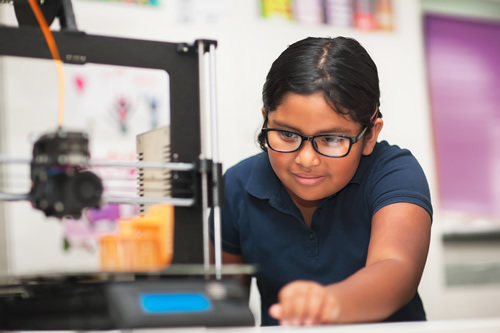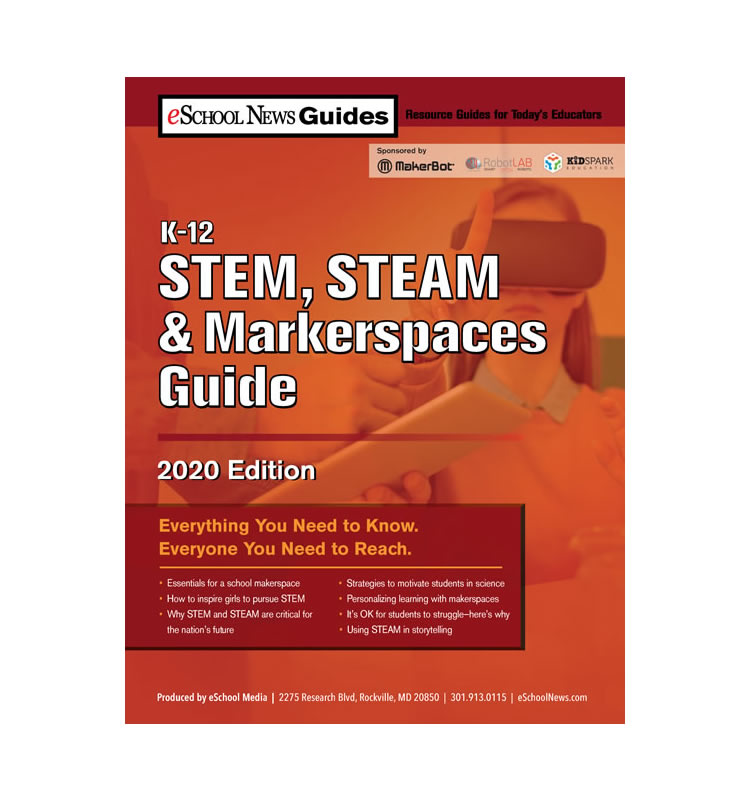By now, we’ve all heard about STEM, the acronym for science, technology, engineering, and math education. Most people have heard of STEAM, which includes arts education along with STEM and allows students to be more creative in their exploration of more technical subjects.
And it’s not a far leap to assume a lot of educators are familiar with makerspaces, which offer open-ended creative spaces for students to explore these concepts as they engage in project-based learning or attempt to solve real-world challenges.
But how are these three things impacting classrooms and the students in them?
STEM and STEAM
When students engage in STEM and STEAM learning, they’re building skills that will make them more marketable as employees in an economy that increasingly demands STEM proficiency.
Many of the jobs today’s students will have don’t presently exist, but most industry leaders agree that these future jobs will require STEM skills and the ability to work collaboratively in a STEM-focused workforce.
Research says the earlier students engage in STEM, the better–a 2019 Brainly study notes that 84 percent of people in a survey say they believe an educational background in STEM makes someone more hireable, and 76 percent say people with STEM backgrounds earn higher salaries than those with traditional educational backgrounds.
Sixty-three percent of people in the same survey say they prefer STEAM learning methods over STEM learning methods.
The group 100Kin10, which works to address the nation’s STEM teacher shortage by training and supporting new STEM teachers, emphasizes supporting students–especially students of color–by recruiting and supporting STEM teachers of color.
Related Content:
eSchool News STEM, STEAM, & Makerspaces Guide
The eSchool News STEM, STEAM, & Makerspaces Guide is here! It features strategies to help you integrate STEM, STEAM, and makerspace education into classrooms, and it offers a look at how these tools engage students and give them valuable skills. A new eSchool News Guide will launch each month–don’t miss a single one!
The nation still struggles to meet the need for teacher diversity, according to a new report from 100Kin10 that looks at 2019 STEM trends and 2020 STEM predictions. People of color represent 50 percent of students in the U.S., but less than 20 percent of teachers–and abundant research shows that students are more likely to pursue STEM education and career paths when they see themselves in their teachers and industry experts.
And STEM doesn’t just mean science and math, though many tend to focus on those two components. The “T” for technology is equally important.
“Technology used to mean getting hardware into schools, but as digital tools have proliferated in classrooms, there is increased understanding that students (and teachers!) need to move beyond being consumers of technology,” according to the 100Kin10 report. “As daily activities at work and in personal life are increasingly driven by tech, students need not only hard and soft skills in technology, but also digital literacy and technological competency.”
Spotlight on a STEAM learning center
Last fall, the Groton Central School District (GCSD) in rural New York opened its new STEAM learning center.
The $4.8 million center is a renovated 8,000-square-foot STEAM lab and shared-learning space. Ashley McGraw Architects merged the district’s curriculum with the overarching concept using form, light, and materials to create a modern learning environment where both teachers and students feel valued, focused, and inquisitive.
According to 2017-2018 New York State Education Department school report card data, less than 30 percent of Groton students in 7th and 8th grade were proficient in English, math, or science.
The multi-purpose STEAM space includes a photo, video, and music editing studio and will be used for a variety of educational programs that are industry-aligned, including: Building Trades, Computer Science, Engineering & Electronics, Agriculture Technology, and Communications & Media Arts.
GCSD Superintendent Margo Martin has gathered data, including Google surveys and social and emotional learning evaluations, which measured how students feel about themselves as learners. And teachers who are part of the STEAM program have reported seeing “completely different students,” as compared to the same students in the general education courses.
“This STEAM lab is poised to become a regenerative project for us,” said Catherine Wolfe, a senior interior designer at Ashley McGraw. “And by that, we mean that we expect the center will work toward helping students develop new skills and also help restore the fabric of the surrounding community on environmental, social, and economic levels.” Community organizations in the small town of 5,950 residents have rallied around the redesigned space as they recognize it has the possibility to become an economic engine.
Maker education
Maker education and makerspaces help students become more aware of challenges around them, and maker education also helps students become more equipped to tackle those challenges and change the world for the better.
Makerspaces give students open-ended, interactive experiences that give students freedom to explore creation and solutions to various problems. It is often cross-curricular, bringing in various core subjects and helping students build strong soft skills, or employability skills, such as creativity, critical thinking, and collaboration.
An important thing to remember about a makerspace is that it does not necessarily need technology to exist and to help students learn. Many makerspaces offer tools such as robotics, while others feature popsicle sticks, LEGOs, fabric, and tape or glue. The important thing is student-guided exploration.
Vermont’s St. Albans City School has a dedicated makerspace open to all students from preK-8. In addition to class assignments in the space, open lab time is also available on a first-come, first-serve basis. Students use this time for school and personal projects where tech might not be required but could add value. Although they miss class for open lab, the teachers recognize the benefits of letting students explore technology to help them achieve their personal and educational goals.
“One of the biggest learning curves for students coming into the makerspace has been realizing the amount of time it takes to make anything, especially when you’re doing it from conception to the prototyping and then trying to actually get a finished product after that,” said Grace Borst, one of two innovation specialists at the school. “But this has also been what has hooked many of our students. They come in to start one project and they have one idea, but they stick around because they figure out all of the other possibilities that they can use the makerspace for—and they keep coming back.”
Actionable strategies to help school leaders and teachers start STEAM programs in their own schools include:
1. Policy makers and school administrators should align budgets with the demands of the future of work, students’ interest, and the potential for higher achievement.
2. Librarians and media specialists should have access to professional development resources so they can successfully lead innovation.
3. Staff meetings and school calendars should be designed in a way that lets librarians to interact more frequently with teachers. This will let them better integrate maker activities with curriculum and scale those activities beyond the library space.
4. Rethinking the design of school libraries will allow STEM and maker integration, collaboration between students, and opportunities for knowledge sharing.
5. Aligning maker activities with community causes gives students the opportunity to become more active citizens and make more meaningful connections between what they do and the needs of the community.
- 4 ways to support work-based learning - April 23, 2024
- Prioritizing inclusivity in game-based learning - April 22, 2024
- Friday 5: Universal Design for Learning - April 19, 2024


